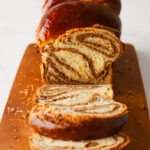
Cozonac Recipe
This Cozonac (Babka) Recipe is a traditional sweet bread originating from Romania, Moldova and other Balkan countries. My recipe takes the ever-intimidating and somewhat-complicated steps of Cozonac and simplifies it for you. Consider this your ultimate guide!
Equipment
- 2x 1 lb. loaf pans
- 1x stand mixer
- 1x food processor
Ingredients
For the dough:
- 5½ cups bread flour
- 1½ cups warm milk
- 1/2 cup granulated sugar
- 5 egg yolks - save the egg whites
- 6 Tablespoons softened butter unsalted
- zest of 1 large orange
- zest of 1 small lemon
- 2 ½ teaspoons instant yeast see note for active dry yeast
- 1/2 teaspoon sea salt
For the tops:
- 2 large egg yolks for brushing over the tops
- 2 Tablespoons butter for greasing the loaf pans
For the filling:
- 4 cups walnuts roasted and finely ground
- 3/4 cup granulated sugar reduce to 1/2 cup for less sweetness
- 5 egg whites
- 2 Tablespoons Cocoa powder
- 2 Tablespoons milk
- 2 teaspoons rum extract
- 2 teaspoons vanilla extract
Instructions
- IMPORTANT READ: Please go back and read through my blog post, step by step photos, expert tips and ingredient notes. I suggest using metric measurements and weighing the dry and wet ingredients for best accuracy. This additional information is for your benefit! Please toggle back from US Customary to Metric conversion in my ingredients section above to follow the metric conversion of my dry and wet ingredients. If you don't have scale, use the fork and fluff method to properly measure flour. Too much flour = a dry cozonac!
Make the dough.
- To a large stand mixer bowl, add flour, sugar, zest of orange and lemon, instant yeast and sea salt. Note: When you are zesting your citrus, do not zest past the color. The white rind is very bitter.Note: Measure flour by weight in grams instead of cups. Shop my exact scale here. (affiliate link) If you don't have a scale, fluff the flour with a fork in its container, and then spoon it into the measuring cup before leveling off with a flat edge. Do not scoop directly into the flour bag. This will add way too much flour to the dough, making it dry!5½ cups bread flour, 1/2 cup granulated sugar, zest of 1 large orange, zest of 1 small lemon, 2 ½ teaspoons instant yeast, 1/2 teaspoon sea salt
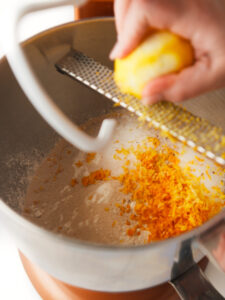
- Using the dough hook attachment, turn on the mixer and slowly add egg yolk, milk and softened butter. Knead on medium-low speed for 10-12 minutes until the dough is soft, smooth and elastic. The dough is initially sticky - this is normal and what makes a great Cozonac. Oil your fingers for easy handling.1½ cups warm milk, 5 egg yolks - save the egg whites, 6 Tablespoons softened butter
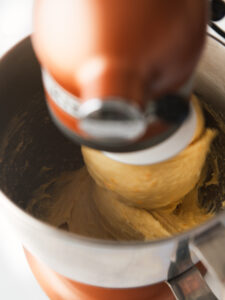
- Form the dough into a ball with your hands and transfer to a large bowl. Lightly coat the bowl and dough with oil, cover with plastic wrap and tea towel. Let it rise for 1 ½ to 2 hours until doubled in size. Don't go by the clock only, keep your eyes on the dough and its growth.
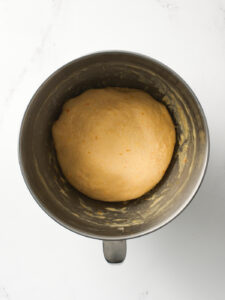
Make the filling:
- When the dough is rising, make the filling. Roast walnuts at 300°F for 10-15 minutes until toasty and fragrant. Set aside to cool. Then, add walnuts to a food processor and pulse at 5 second intervals for up to one minute until finely ground and no big chunks are seen. This finely ground texture makes the filling easily spreadable. Note: Do not grind the walnuts while they are still hot. Pulse at 5 second intervals for up to one minute until finely ground and no big chunks are seen.4 cups walnuts
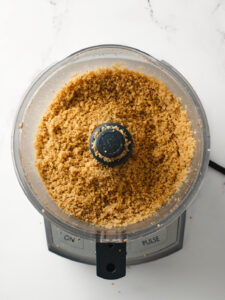
- In a separate large bowl, use an electric hand mixer and whisk the egg whites until white and bubbly with soft peaks.5 egg whites
- Then, add the finely ground walnuts to the whipped egg whites, along with cocoa powder, sugar, milk, rum extract and vanilla extract. Use a rubber spatula or spoon to fold the ingredients together until combined into a rich, chocolate color and spreadable consistency.Note: If you make the filling too far in advance, the walnuts absorb the surrounding liquid over time, causing it to thicken. If the filling is thick to spread, you can add small amounts of milk and mix until desired spreadable texture but not runny.Note: If you prefer a less sweet filling, decrease sugar to 1/2 cup.3/4 cup granulated sugar, 2 Tablespoons Cocoa powder, 2 teaspoons rum extract, 2 teaspoons vanilla extract, 2 Tablespoons milk
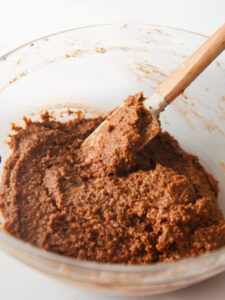
Roll and fill the dough.
- Butter the inside edges and bottoms of two loaf pans and set aside. Punch the dough down and place on a dry, clean surface. Lightly flour as needed.2 Tablespoons butter
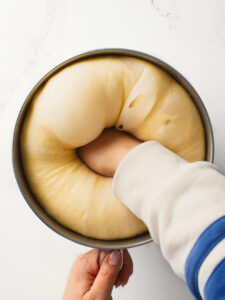
- Place the dough on a kitchen scale and divide that number into 4 equal pieces. This recipe makes 2 large loaves. You will use 2 pieces per loaf.
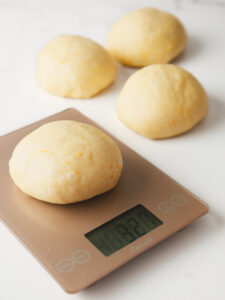
- Working with one piece at a time, start out by using your hands to press and form the portion of dough into a small rectangle. Use a a rolling pin to reinforce the shape. Go back and forth between using the rolling pin and gently pulling and guide the dough into a rectangle. The dough is very soft and stretchy. Make the rectangle as wide your loaf pan and as long as two loaf pans side by side - about 9 inches by 18 inches. Note: You need to roll it out much thinner than you are familiar with in order to achieve those iconic layers of filling but not too thin or you risk excessive cracks during baking. You should roll out the dough enough so you barely see through it. Lightly dust with flour as needed. See photo for reference!
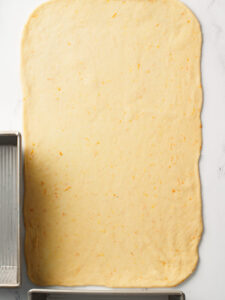
- Divide the filling into four equal portions. Use a flat edge spatula to thinly spread one portion of filling onto the rolled out dough, leaving a small border on the edges. DO NOT roll from the longer side or you will have trouble fitting the bread in the pan. Starting on the shorter side, tightly roll into a log, pinch the seams together. Once pinched, gently roll back and forth to reinforce the seams together. See photo for reference! Set aside and repeat 3 more times for a total of 4 logs.
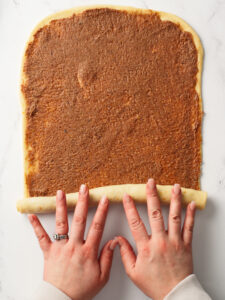
- For full, step by step photo of the braiding process, go back to the blog post. Place two logs parallels to one another. Take the bottom portion of one log and twist over the other log, creating the first braid. Do this with the top portion to create three twists. Press the two ends of the newly, braided loaf together with your palms. Place the braided loaf in the prepared loaf pan. Repeat with the remaining two logs.
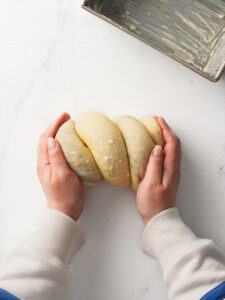
Let it rise.
- Cover with plastic wrap and let it rise until puffy - this can take anywhere between 45 to 60 minutes, depending on the warmth of your kitchen. Do not rush this step.
Bake.
- While the loaves are rising, preheat the oven to 350°F / 176°F. When the loaves are ready to bake, brush the tops well with beaten egg yolks for a golden finish. Discard any leftover egg yolk.2 large egg yolks
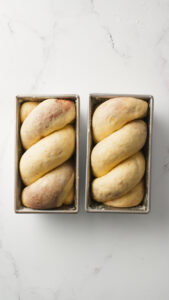
- Bake for 48-50 minutes until deep brown. It is normal for the sides of the loaf to crack during the baking process. Do not under-bake due to dark color but also do not over-bake as it will continue to bake when removed from the oven! Leave in the pan for 15 minutes before removing to cool on a baking rack. Note: Just like my Brown Butter Banana Bread Recipe, I like to alternate the loaves cooling on their sides so the center doesn't sink in. See photo for reference!
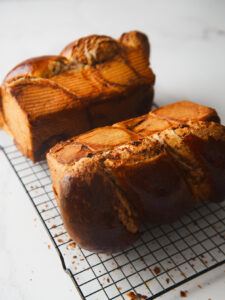
Video
Notes
- Measure flour by weight in grams instead of cups. Shop my exact scale here. (affiliate link) If you don't have a scale, fluff the flour with a fork in its container, and then spoon it into the measuring cup before leveling off with a flat edge. Do not scoop directly into the flour bag. This will add way too much flour to the batter, making it dry!
- If using active dry yeast, first measure 240ml or 1 cup of warm milk from the recipe in a wide mouth cup or bowl. Add in a teaspoon of sugar and sprinkle the yeast on top. Whisk together to combine and let it sit for 5-10 minutes until foamy and bubbly on top. Then, add to the dry ingredients, along with the remainder of the milk and proceed with baking directions. For extended instructions, see Active Dry Yeast vs. Instant Dry Yeast blog post.
- The more in advance you make the filling, the thicker it becomes. This is because the ground walnuts absorb the surrounding liquid. Stir in small amounts of milk until the texture is spreadable but not runny. See recipe card for full details.
Nutrition
Calories: 453kcalCarbohydrates: 52gProtein: 13gFat: 23gSaturated Fat: 3gPolyunsaturated Fat: 15gMonounsaturated Fat: 4gCholesterol: 65mgSodium: 22mgPotassium: 226mgFiber: 4gSugar: 14gVitamin A: 94IUVitamin C: 0.4mgCalcium: 47mgIron: 2mg
The provided nutritional value above is an estimate per serving. 100% accuracy is not guarenteed. Please see Nutrition Information Disclaimer in our Privacy Policy.
Nutrition Information Disclaimer Have you tried this recipe?Please leave a comment/review below!